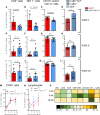CD91 on dendritic cells governs immunosurveillance of nascent, emerging tumors
- PMID: 30944251
- PMCID: PMC6483634
- DOI: 10.1172/jci.insight.127239
CD91 on dendritic cells governs immunosurveillance of nascent, emerging tumors
Abstract
The immune system detects aberrant, premalignant cells and eliminates them before the development of cancer. Immune cells, including T cells, have been shown to be critical components in eradicating these aberrant cells, and when absent in the host, incidence of cancer increases. Here, we show that CD91, a receptor expressed on antigen-presenting cells, is required for priming immune responses to nascent, emerging tumors. In the absence of CD91, effector immune responses are subdued, and tumor incidence and progression are amplified. We also show that, consequently, tumors that arise in the absence of CD91 express neo-epitopes with indices that are indicative of greater immunogenicity. Polymorphisms in human CD91 that are expected to affect ligand binding are shown to influence antitumor immune responses in cancer patients. This study presents a molecular mechanism for priming immune responses to nascent, emerging tumors that becomes a predictor of cancer susceptibility and progression.
Keywords: Adaptive immunity; Antigen presentation; Cancer; Immunology.
Conflict of interest statement
Figures




References
Publication types
MeSH terms
Substances
Grants and funding
LinkOut - more resources
Full Text Sources
Medical
Molecular Biology Databases
Miscellaneous

